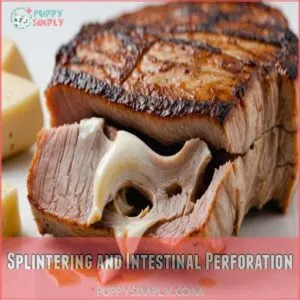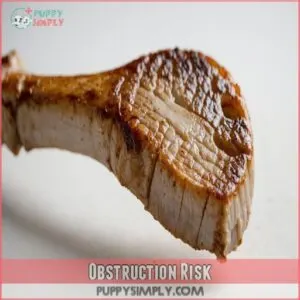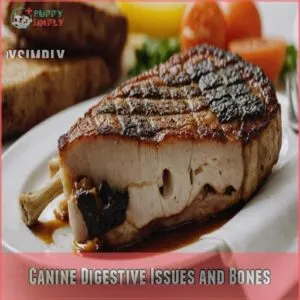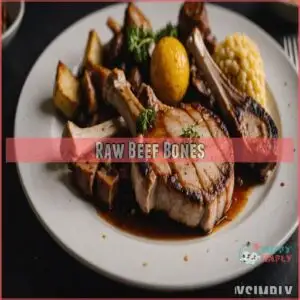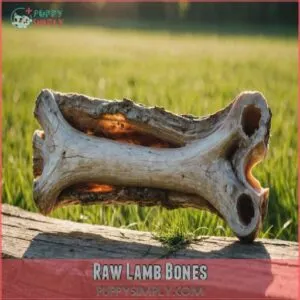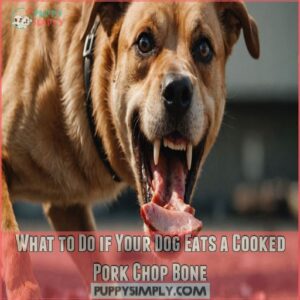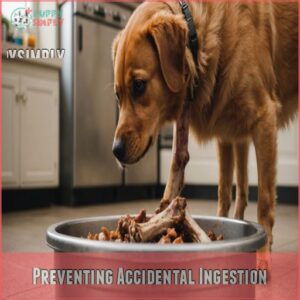This site is supported by our readers. We may earn a commission, at no cost to you, if you purchase through links.
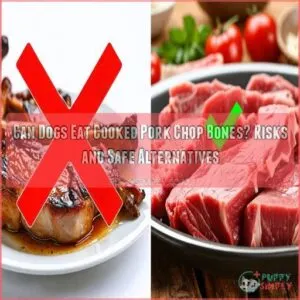
These sharp pieces could cause choking, intestinal blockages, or even pierce through your dog’s intestines, leaving you both in a pickle. Better safe than sorry, right?
Instead, consider safer chew options like raw beef bones or non-edible chew toys specifically made for dogs. This will keep Sparky’s tail wagging, but it’ll also keep him healthy and safe.
So, steer clear of cooked pork chop bones and discover safer alternatives that make snack time just as fun!
Table Of Contents
- Key Takeaways
- Risks of Cooked Pork Chop Bones
- Canine Digestive Issues and Bones
- Safe Alternatives to Pork Chop Bones
- What to Do if Your Dog Eats a Cooked Pork Chop Bone
- Signs of Complications in Dogs
- Preventing Accidental Ingestion
- Veterinary Care for Bone Ingestion
- Frequently Asked Questions (FAQs)
- Can dogs eat pork bones?
- Can one eat pork?
- Are Pork Chop bones safe for dogs to chew on?
- What if my dog ate a pork chop bone?
- Can dogs eat pork chops?
- What happens if a dog eats a cooked pork chop?
- Are cooked pork chop bones ok for dogs?
- What cooked bones can dogs eat?
- Can dogs eat cooked chop bones?
- Can dogs eat pork chops cooked?
- Are cooked pork chop bones nutritious for dogs?
- How long does it take for bones to digest?
- Can pork chop bones cause dental issues in dogs?
- Do dogs enjoy the taste of pork bones?
- What are the signs of choking on bones?
- Conclusion
Key Takeaways
- Don’t give your dog cooked pork chop bones—they can splinter easily and cause serious harm, such as choking or intestinal blockages.
- Raw beef or lamb bones, as well as durable chew toys, are safer alternatives that will keep your dog’s tail wagging.
- Secure trash cans and educate family members to prevent accidental ingestion of dangerous bones.
- If your dog eats a cooked bone, watch for signs like vomiting or lethargy and contact your vet immediately for guidance.
Risks of Cooked Pork Chop Bones
You shouldn’t give your dog cooked pork chop bones because they can easily splinter, causing serious injuries like intestinal perforation. Cooked bones are actually more hazardous than raw ones, as explained in the risks of giving dogs cooked pork bones.
The risk of obstruction is also high, which can lead to severe health issues for your furry friend.
Why Cooked Bones Are Not Recommended
Cooked pork bones are a recipe for disaster for dogs. They’re not just risky but downright dangerous.
Here’s why:
Splintering risk: Unlike raw bones which can splinter, but generally remain in larger pieces, cooked bones easily break into sharp fragments because they become brittle, much like cooked bones’ dangers. Cooked bones easily break into sharp fragments.
Digestive upset: Bone splinters can lead to tummy troubles.
Choking hazards: Pieces can get stuck in the throat.
Vet advice: Always skip giving cooked bones to avoid these risks.
Consider shopping for safer dog bone alternatives online, such as those found in dog bone alternatives stores, to prevent these risks.
Keep your pup safe with alternatives!
Splintering and Intestinal Perforation
You might think tossing a pork chop bone to your dog is harmless, but beware of bone shard dangers.
These little menace can lead to intestinal perforation, causing severe pain and potential dog surgery risks.
Preventing splinters is key—remember, cooked pork bones aren’t safe for dogs.
Keep your pup’s diet free from these dietary hazards to guarantee their safety and health.
Obstruction Risk
Besides splintering, cooked pork chop bones pose a significant obstruction risk.
Their shape and size can easily cause intestinal blockages, especially in smaller dog breeds.
A bone lodged in your dog’s throat is a serious choking hazard.
Always supervise your pup when they’ve access to bones, and choose safer alternatives if you’re unsure.
Remember, prevention is key!
Canine Digestive Issues and Bones
Feeding your dog cooked pork chop bones can lead to serious digestive issues, especially if they already have stomach problems, as like rib bones, they can splinter easily and cause a choking hazard risk. Feeding your dog cooked pork chop bones can lead to serious digestive issues, especially if they already have stomach problems.
The marrow inside bones, while tasty, can worsen these issues and leave your furry friend feeling quite unwell.
Exacerbating Existing Digestive Problems
Digestive issues can turn any dog owner’s day upside down.
Imagine your furry friend’s gut health acting up after munching on cooked pork bones.
These bones can spell trouble, especially for dogs with sensitive stomachs.
While your pup might think they’re getting a treat, bones can worsen pre-existing conditions.
Stick to a raw diet or suitable dog food to keep those pesky digestive gremlins at bay and maintain your pet’s health stays on track.
Bone Marrow and Its Effects
Though bone marrow is a tasty treat for many pups, it isn’t without risks.
Some dogs might love the rich flavor, but marrow digestion can be tricky for those with sensitive tummies.
Just like Aunt Mabel’s chili, it can cause gastrointestinal upset or even allergies.
Understanding male psychology, like how men want to be providers and take care of their partners in a relationship, can be just as complex as understanding canine digestive issues.
While marrow supplements offer benefits, cooked pork bones are a big no-no.
They can splinter, posing choking hazards and making pork bones unsafe for dogs.
Safe Alternatives to Pork Chop Bones
You love your dog, and keeping them safe means finding chew alternatives that won’t splinter and cause harm.
Raw beef or lamb bones and sturdy chew toys are excellent choices that keep your furry friend happy and healthy.
Raw Beef Bones
Raw beef bones can be a safer bet for your furry friend.
Unlike cooked pork bones, raw beef bones are less likely to splinter and cause harm.
Chewing time and bone size matter—larger bones suit big dogs, giving them a safe chew.
Remember, observations on your dog’s breed and behavior are important for ensuring their safety.
Enjoy the peace of mind with raw beef bones.
Raw Lamb Bones
Lamb bones offer a safe alternative for your dog’s chewing needs—think of them as a culinary puzzle without the risk of choking.
Unlike cooked pork chop bones, these raw bones won’t splinter easily, making them perfect for canine play.
Choose large, sturdy raw lamb bones to make sure they don’t break into smaller pieces.
It’s an easy bone size guide: think big and safe!
Safe Chew Toys
So, you’ve considered lamb bones—smart.
Let’s talk about safer alternatives.
Many great chew toys exist, and you can find a wide selection of them, including a variety of rubber dog toys online.
Here are some types:
- Durable nylon toys.
- Rubber toys.
- Toys made of natural materials like wood.
- Rope toys.
These options offer similar benefits to bones, like dental cleaning, without the risks of splintering or choking.
Remember, choosing the right size is key for your dog’s safety.
Avoid cooked pork bones; they’re a recipe for disaster!
What to Do if Your Dog Eats a Cooked Pork Chop Bone
If you catch your dog munching on a cooked pork chop bone, quick thinking and a steady hand are your best friends.
Don’t panic—carefully remove any remaining pieces and call your vet for advice on keeping your furry friend safe.
Immediate Action Required
Spot your pup munching on a cooked pork chop bone? It’s time to leap into action.
First, make sure your dog isn’t choking—watch for frantic pawing or coughing.
Since cooked bones can splinter and puncture a dog’s digestive tract, as seen with cooked chicken bones risks, Call your vet for immediate advice; they’re your lifeline in this scenario.
While waiting, observe your dog for signs like vomiting or lethargy.
Remember, quick actions can prevent serious bone splinter damage.
Removing The Bone
If you catch your dog munching on cooked pork bones, act fast to prevent any choking hazards.
Carefully open your dog’s mouth and remove the bone without causing distress.
Don’t panic, but make sure you’re gentle yet firm, using safe removal tools.
Remember, cooked pork bones are a splintering nightmare, posing risks to dog bone safety.
Stay vigilant!
Contacting Your Veterinarian
Give your vet a quick call after your dog munches on cooked pork chop bones.
They’ll provide important bone ingestion advice, guide you on whether an emergency vet visit or urgent care options are needed, and help with vet appointment scheduling.
Keeping your furry friend’s safety in check helps prevent potential veterinary emergencies.
Signs of Complications in Dogs
If your dog has munched on a cooked pork chop bone, keep an eye out for signs like vomiting, diarrhea, or abdominal pain.
These symptoms can indicate serious complications, just like when you regret eating that questionable gas station burrito.
Vomiting and Diarrhea
Vomiting and diarrhea in your dog after munching on cooked pork chop bones aren’t just unfortunate messes; they’re red flags.
These symptoms could mean the bones are causing digestive problems, like blockages or scraping your dog’s insides.
When you notice these issues, it’s time to get veterinary help—before things spiral out of control.
Safety first, always!
Abdominal Pain and Bloating
How’s your pup feeling?
Abdominal pain and bloating after a cooked pork chop bone?
These are serious signs!
They could mean a blockage or irritation.
Seek vet help immediately.
Don’t delay; prompt action is vital for your dog’s health.
Prevention is key: avoid cooked pork bones completely.
Lethargy and Loss of Appetite
Spotting signs like lethargy and loss of appetite after your dog devours cooked pork chop bones is like finding a red flag waving in the wind.
If your dog’s loss of appetite persists for 48 hours or is accompanied by other concerning symptoms like vomiting or diarrhea, it’s important to seek immediate veterinary attention to address potential dehydration and stomach upset; understanding how to get dog to eat when sick can be key to recovery.
Here’s what you need to know:
- Look for decreased energy.
- Notice if your dog skips meals.
- Watch for changes in overall behavior.
- Contact your vet if these symptoms appear.
Always prioritize dog health!
Preventing Accidental Ingestion
To prevent your dog from accidentally munching on cooked pork chop bones, make sure to secure trash cans tightly and keep leftovers out of reach.
Educating family members on the dangers of bone ingestion can add an extra layer of protection—after all, prevention is better than a trip to the vet!
Securing Trash Cans
Trash can lids should always be your first line of defense against a curious pup’s exploration.
Invest in dog-proof bins or use child safety locks.
A clever canine can outsmart unsecured trash, leading to accidental feasts of cooked pork bones—not ideal given the splintering risk.
Keeping your trash secure prevents accidents and protects your dog’s safety and your peace of mind.
Keeping Leftovers Out of Reach
Don’t leave those pork chop bones lying around!
Dog-proofing your kitchen means securing food storage and keeping leftovers out of reach.
These leftover dangers can lead to choking and are toxic, making pet safety a top priority.
Use safe snack options instead.
Remember, countertops aren’t dog-proof—store things securely to avoid any cooked pork bone mishaps.
Educating Family Members
While keeping leftovers out of reach is wise, everyone at home needs to be clued in.
Imagine this: your dog snagging a cooked pork bone someone didn’t realize posed a threat.
It’s important to inform family members about the dangers of cooked bones splinter easily.
So, chat with the family about bone safety and store food securely.
Dog training and safe chew alternatives can serve as added layers of protection, avoiding unexpected vet visits.
Veterinary Care for Bone Ingestion
If your dog swallows a cooked pork chop bone, keeping a close eye on their health is very important to prevent complications.
Monitoring their stool is essential.
Considering blood work is also important.
Monitoring Your Dog’s Health
Keeping a close eye on your pup is key after a potential bone mishap.
Notice any changes? Here’s what to watch for:
- Vomiting
- Diarrhea
- Lethargy
- Appetite loss
- Abdominal pain
These signs could mean trouble.
If you see anything unusual, call your vet immediately. Better safe than sorry!
Stool Checks and Blood Work
Wondering if everything’s passing smoothly?
Keep an eye on your dog’s stool frequency and check for any blood in stool after they eat cooked pork bones.
If something seems off, a stool analysis or blood work might be needed.
These tests help vets spot issues early.
It’s like getting a health report card for your pup—making sure all’s well inside.
Emergency Surgery and Treatment
If bone splinters go south, emergency surgery might be on the table.
Costs can be hefty, but pet insurance could lighten the load.
Anesthesia adds risk, especially if your dog’s a bit of a heavyweight.
Post-op recovery varies—expect complications like dog choking.
Make sure to schedule regular vet checks.
Prognosis? With swift action, your tail-wagger could soon be back fetching sticks.
Frequently Asked Questions (FAQs)
Can dogs eat pork bones?
Feeding pork bones to dogs is playing with fire!
Even if cooked, they can splinter easily, posing serious risks like internal injuries and blockages.
Stick with safer options like chew toys or approved bones to keep your pup safe.
Can one eat pork?
Sure, you can eat pork!
It’s a popular protein that’s tasty when cooked properly.
Just make sure it’s fully cooked to avoid any pesky bacteria or parasites.
Think juicy pork chops or flavorful pulled pork sandwiches!
Are Pork Chop bones safe for dogs to chew on?
Like tempting treats, cooked pork chop bones are a big no-no for your furry friend.
They splinter easily, posing a serious choking or internal injury risk.
Choose safer chew toys instead!
What if my dog ate a pork chop bone?
If your dog ate a pork chop bone, monitor them closely for signs like vomiting, diarrhea, or discomfort.
Check their stool for bone fragments.
Contact your vet if you notice any worrying symptoms.
Can dogs eat pork chops?
About 60% of dog owners share table scraps.
Cooked pork chops aren’t the best choice for dogs due to spices and fats, which can upset their stomachs.
Opt for plain, unseasoned pork instead for canine safety.
What happens if a dog eats a cooked pork chop?
When a dog eats a cooked pork chop, it risks splintering bones, which can cause choking, internal injuries, or blockages.
Watch for vomiting, diarrhea, or discomfort, and consult your vet if any worrying symptoms appear.
Are cooked pork chop bones ok for dogs?
Giving your dog cooked pork chop bones is like playing with fire—they can splinter and cause serious harm.
Stick to safe chews designed for dogs instead to keep their tail wagging and their health intact.
What cooked bones can dogs eat?
Dogs are at risk of internal damage from splintered cooked bones, which can cause a digestive obstruction. Dogs shouldn’t eat cooked bones, including pork chops.
Cooked bones can splinter easily, posing serious health risks like choking or internal injuries.
Opt for safe chew toys or specially prepared dog treats to satisfy your pet’s chewing instincts.
Can dogs eat cooked chop bones?
Cooked chop bones can be dangerous for dogs due to their tendency to splinter, causing potential harm like choking or internal injuries.
It’s safer to offer your dog chew toys or dental treats instead.
Can dogs eat pork chops cooked?
It’s a bone-headed idea!
No, cooked pork bones are a big no-no for your pup.
They splinter easily, causing painful injuries.
Stick to safer chews to keep your furry friend safe and sound.
Are cooked pork chop bones nutritious for dogs?
You’re likely wondering if cooked pork chop bones are a nutritious snack for your furry friend, but unfortunately, they’re not.
In fact, they can be hazardous due to their potential to splinter.
How long does it take for bones to digest?
Dogs take around 12 to 72 hours to digest bones, depending on the size and type of bone, as well as the dog’s size and digestive health.
Always monitor for symptoms like vomiting or changes in appetite.
Can pork chop bones cause dental issues in dogs?
Chewing cooked pork chop bones is like biting on a time bomb for dental troubles and splinters.
They can fracture teeth and cause irritation or punctures in the mouth, leading to infections or other serious health issues.
Do dogs enjoy the taste of pork bones?
Many dogs do find pork bones tasty, but their safety comes first.
Eating cooked pork bones can be risky, as they may splinter, posing a danger, similar to the risks associated with feeding dogs pork bones, such as choking or intestinal blockage.
Always prioritize safe alternatives to keep your furry friend happy and healthy.
What are the signs of choking on bones?
If your dog starts coughing, gagging, or pawing at its mouth, it might be choking on a bone.
Rapid breathing or panicked behavior are serious signs too.
Stay calm and try to help immediately or contact a vet.
Conclusion
Remember, can dogs eat cooked pork chop bones? No way!
You’ve learned the dangers of splintering bones and intestinal blockages.
Now you know safer alternatives like raw beef bones or durable chew toys exist when avoiding risky cooked bones.
Prioritize your dog’s health; choose wisely.
A little preventative care goes a long way in ensuring a happy and healthy pup.
Keep those cooked bones far away, and enjoy those happy tail wags!
Don’t risk it – your dog’s safety is worth it.


